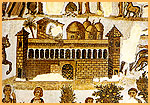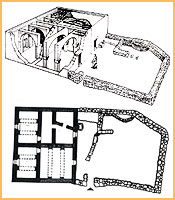|
The Early Byzantine Countryside:
land use and habitat
In the fourth-century text of the Expositio
totius mundi et gentium  agriculture
stands out as the economic backbone of a number of provinces:
Asia Minor, Syria and Palestine exported wine and olive oil;
Egypt, Sicily, Thessaly and Thrace were the granaries of the
empire. Wine and olive-oil were often produced in barren marginal
areas. In the arid landscapes of Palestine, namely the Negev
desert, Samaria and the Golan. extensive stone walls, dikes
and cisterns, ensured maximum use of land and best conservation
of water. Likewise, the Limestone Massif of nothern Syria
bears the remains of a flourishing rural society. Here, developpement
was based on village settlements with well-built houses and
impressive churches. Though dependent on cities to sell their
products, villages remained largely unaffected by the rapid
decline of urban life in the late sixth century. Indeed, the
Syrian Massif continued to prosper long after Antioch and
Apamea were destroyed by fire, earthquakes and warfare. The
Hauran (Transjordan), Cilicia and Lycia (Asia Minor) show
a parallel development, with villages still densely populated
in the sixth century, and progressively abandonned as late
as the tenth century. agriculture
stands out as the economic backbone of a number of provinces:
Asia Minor, Syria and Palestine exported wine and olive oil;
Egypt, Sicily, Thessaly and Thrace were the granaries of the
empire. Wine and olive-oil were often produced in barren marginal
areas. In the arid landscapes of Palestine, namely the Negev
desert, Samaria and the Golan. extensive stone walls, dikes
and cisterns, ensured maximum use of land and best conservation
of water. Likewise, the Limestone Massif of nothern Syria
bears the remains of a flourishing rural society. Here, developpement
was based on village settlements with well-built houses and
impressive churches. Though dependent on cities to sell their
products, villages remained largely unaffected by the rapid
decline of urban life in the late sixth century. Indeed, the
Syrian Massif continued to prosper long after Antioch and
Apamea were destroyed by fire, earthquakes and warfare. The
Hauran (Transjordan), Cilicia and Lycia (Asia Minor) show
a parallel development, with villages still densely populated
in the sixth century, and progressively abandonned as late
as the tenth century.
Archaeological evidence for land use in the eastern
provinces comes  mainly
from these marginal areas. Much less is known of the fertile
plains, which have been farmed without interruption for many
centuries, and where hardly any visible structures survive.
It is possible that much of the good land was occupied by
large estates (villae) farmed by tenants (as opposed to the
small-scale landowners and free peasants of the more secluded
regions). Many suburban villas in the eastern provinces were
indeed linked to the exploitation of estates. Relatively modest
as compared to their sumptuous rural counterparts of the Roman
west, they lie fairly close to towns, and were visited seasonally
by their aristocratic owners who wished to inspect their flocks
and plantations, to hunt, or to escape the heat of the city
in summer. mainly
from these marginal areas. Much less is known of the fertile
plains, which have been farmed without interruption for many
centuries, and where hardly any visible structures survive.
It is possible that much of the good land was occupied by
large estates (villae) farmed by tenants (as opposed to the
small-scale landowners and free peasants of the more secluded
regions). Many suburban villas in the eastern provinces were
indeed linked to the exploitation of estates. Relatively modest
as compared to their sumptuous rural counterparts of the Roman
west, they lie fairly close to towns, and were visited seasonally
by their aristocratic owners who wished to inspect their flocks
and plantations, to hunt, or to escape the heat of the city
in summer.
Suburban villas share the same characteristics as urban
mansions Peasant dwellings were naturaly more rustic. They
normally consisted of a number of superimposed units arranged
within an enclosed courtyard: living quarters, storage rooms,
stables, and sometimes an olive- or winepress. The more elegant
houses have balconies, double windows, and peristyle courtyards,
but even these lacked amenities such as baths and heating.
In Cilicia, Syria, Palestine and Transjordan, where the rural
habitat is well documented, houses were solidly built of local
stone using the dry-stone technique. Stone carvings adorn
the faŤades, and frame the doorways and windows. Another typical
feature is the stone ceiling, made of rectangular slabs supported
by arches or beams, the latter resting on stone corbels projecting
from the walls. Interior partitions pierced by windows supported
the weight of the ceilings, the windows serving as mangers
or cupboards. Villages consisted of irregular clusters of
houses, with narrow unpaved streets and few if any public
buildings (usually a church or a synagogue).
|